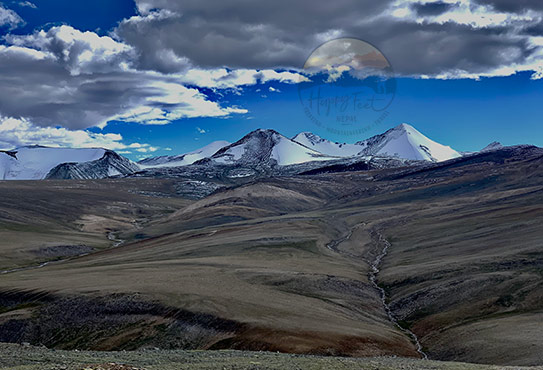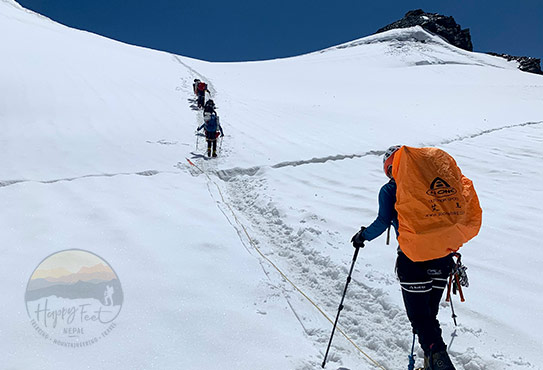Sunday - Friday: 9 AM - 4 PM
Kang Yatse-I is a mountain peak in India’s Markha Valley of the Ladakh region. It stands at an elevation of 6,400 meters (21,000 feet) and is considered one of the most challenging and popular trekking peaks in the Ladakh region. The Kang Yatse offers breathtaking views of the surrounding landscape, including the Zanskar and Karakoram ranges. The trek to Kang Yatse-I involves crossing several high-altitude passes and glacial streams, making it a challenging but rewarding adventure for experienced trekkers. The best time to undertake this trek is between June and September.
A scenic flight from Delhi floating over the monsoon clouds puts you at Leh Airport. As you walk through the dramatic runway just below Leh town, you will receive a warm welcome from our local representatives at Leh, who are mainly Buddhist. The journey to your lodge is 5 kilometres and takes 20 minutes—no activity for the rest of the day. Take rest and acclimatize. But who can stop to experience the beauty of the newly arrived town? A colourful market just beneath the old Royal Palace is a not-to-miss place for a walk before initiating a trek.
Leh is Ladakh’s largest town and capital, at 3,500 meters above sea level, surrounded by snow-capped mountains. The city is known for its stunning natural beauty, rich cultural heritage, and adventure tourism opportunities. It is also a popular destination for trekkers, mountaineers, backpackers, and Buddhist pilgrims. The town has many ancient monasteries and palaces that showcase the region’s unique architecture and history. The people of Leh are warm and friendly, and the city has a laid-back vibe that makes it a perfect place for a peaceful getaway.
Today, you will visit some ancient monasteries in this region, for which you need to drive about 90 kilometres. Shey Palace is located about 15 km from Leh. Shey Palace is a historic Buddhist monastery in Ladakh’s Leh district. The Shey Palace was founded at the beginning of the 17th century AD by Deldan Namgyal and was once the summer capital of the Ladakh kingdom. It is renowned for its beautiful architecture that showcases a blend of Tibetan and Indian styles. The palace (inside the Dresthang Gompa) also houses a 12-meter-high statue of Shakyamuni Buddha made of gilded copper, considered the largest in the region. There are lots of Stupas and Gonpas built around the palace. The Shey Palace monastery is a popular tourist destination that attracts all kinds of visitors who come here to experience its stunning beauty and learn about the rich cultural heritage of Ladakh.
Thiksey Monastery is a Tibetan Buddhist monastery near Shey Palace, about 17 km from Leh. The monastery is on top of a hill and offers stunning scenery of the surrounding mountains. It is one of the largest monasteries in Ladakh and is home to a community of monks who follow the Gelu Hemisgpa tradition of Buddhism. The monastery complex houses several temples, prayer halls, and other buildings, including a nunnery. The monastery’s main prayer hall contains a 15-meter-high statue of Maitreya Buddha, the giant statue in Ladakh. The monastery also hosts an annual festival called the Gustor Festival, celebrated with great pomp and show. The festival involves the performance of sacred dances by the monks and attracts many tourists worldwide.
Hemis Monastery, located about 45 km south of Leh, is a Himalayan Buddhist monastery in the Hemis region of Ladakh. The Hemis Monastery is founded in a lovely mountain valley, surrounded by streams and fronted by long Mani walls. It was established in the 11th century and is considered Ladakh’s largest and wealthiest monastery. The monastery is known for its stunning architecture, beautiful frescoes, and rich collection of ancient relics, including thangkas, murals, and statues. Being a Drukpa-order Buddhist monastery, Hemis Monastery is also famous for its annual Hemis Festival, celebrating the birth anniversary of Guru Padmasambhava, the founder of Tibetan Buddhism. The festival is a colourful and vibrant event that attracts thousands of visitors from all over the world. Overnight at Leh.
After breakfast, drive to Zingchen/Rumbak and trek to Yurutse, 4100m. It will take around 6 hours, including a 4-kilometre drive from Leh to Zingchen. From Zingchen to Yurutse, we will pass via Rumbak Valley, known as the Leopard capital. Rumbak Valley is a picturesque valley in Ladakh. Rumbak is nestled amidst the towering peaks of the Stok Range and is known for its stunning natural beauty. The valley is home to various flora and fauna, including the elusive snow leopard, spotted during winter. The small village of Rumbak is located in the valley and is inhabited by the local Ladakhi people, who are known for their hospitality and traditional way of life. The rugged terrain and breathtaking vistas fill the Rumbak Valley, which makes it a famous destination for nature enthusiasts and trekkers. Overall, Rumbak Valley offers the Himalayan region’s raw beauty, making it a not-to-miss destination for anyone. There is a beautiful view of Stok Kangri, one of the highest mountains in this range.
Today, we start early in the morning because we need to ascend the Kandala pass, gaining 800m altitude over Yurutse Camp. The Kandala Pass is a mountain pass at an elevation of around 16,500 feet above sea level and connects the Suru Valley in Kargil district with Zanskar Valley in Ladakh. The Kanda La offers breathtaking sceneries of Ladakh Himalaya and is a popular destination for adventure enthusiasts. However, its high-altitude terrain demands proper acclimatization and preparation before crossing it. The total walking distance is 10.2 kilometres, and takes a 5-6 hour walk. From the pass, we have a spectacular view of the highest mountain of Ladakh, the majestic Nun and Kun, in the great Himalaya of the Zanskar range.
Today, it is a bit easy on flat terrain, but walking takes 5-6 hours because the distance is 16.8 kilometres. The first one and a half hours are downhill walks along Shingo Chu until we reach the Skui junction. Skui Village is a small and beautiful settlement in the Markha Valley of Ladakh. The village is at an altitude of around 3,400 meters, surrounded by stunning snow-capped mountains and lush green fields. Skui is known for its traditional Ladakhi houses, made of stone and clay and adorned with colourful prayer flags. The village is also famous for its apricot orchards, a significant source of livelihood for the locals. Tourists visiting Skui can enjoy scenic walks in the surrounding hills, visit the nearby Buddhist monasteries, and experience the unique local culture and hospitality of the Ladakhi people. After Skui, we turn left towards Markha and trek along the river.
Walking along the Markha River will take 6 to 7 hours on flat terrain, and the total distance is 13.6 kilometres. Today, we will have to use our sandals/floaters as we will have to cross the River several times.
Trek to Thochungtse via Hanker village, where you can see Hanker’s Castle on the hilltop. Hanker’s Castle, also known as Hankar Dzong, is a historic fortification in the Hankar village of Ladakh, India. The Castle is believed to have been built in the 16th century and served as a strategic outpost for the local rulers. The Hankar Dzong is founded on a hilltop overlooking the village, which has stunning mountain scenery. It is made of stone and features a traditional Ladakhi architectural style, with intricate wood carvings and colourful murals adorning the walls. Today, Hanker’s Castle is a popular tourist destination in Ladakh, and it attracts visitors from all over the world who want to explore Ladakh’s rich history and culture. The total walking distance is 10.5 kilometres and takes 5-6 hours.
After trekking to the top of the first ridge with hundreds of Cairns, note the beautifully eroded rock spikes down to the left and the Kang Yatse massive (6400m) on the right. The trails rise gently, pass many Mani walls, and ascend gently towards Base Camp. The walking distance is only 6.8 kilometres, but it takes 5 hours.
Breakfast and enjoy a rest day. Climbing equipment gets distributed to all the members. The morning is for basic training and altitude gain walks. Demo and practice with climbing equipment from your Climbing Guide. Back to Base Camp for Lunch and a free day to rest. Early dinner and rest for early climbing, which usually begins in the early morning (according to the time set by your Climbing guide).
Leave for the summit at midnight. The climbing route involves loose rocks and a steep section, and it is 550m from Camp II. About 18 ice walls challenge the climbers with a 70—to 80-degree angle to the summit.
Enjoy the sunrise and vast panorama from the summit. Take essential pictures and descend back to Camp I from the same route.
After breakfast, leave Kang Yatse Base Camp and trek towards the Kongmaru La Pass. The scenery from the top of Kongmaru La is the first view of the Indus Valley and Ladakh ranges. If you turn around, Kang Yatse is still watching over you. It is a magnificent sight! Descend to Chokdo Village through the stunning Shang Gorge to the roadhead, a 15.2-kilometre walk. Vehicles will be ready to pick you up and drive you to Leh.
If you climb the summit as scheduled, you will have a free day to shop for souvenirs and local products. The evening is for a farewell dinner. If you spend one more day climbing Kang Yatse, you will depart on this day.
A moderate trek of 2 weeks will take you to altitudes above 6000m. A routine day will have over 5-6 hours of walking with regular deals of ascending and descending on sparsely trodden trails. The terrain will vary on these treks, and expect walking on with a mix of wilderness, terrain, altitude, moraines, boulders, fields and small glaciers. Acclimatization is a concern, but the itinerary is carefully designed to allow proper acclimatization. This trek involves exposure to high-altitude Sun and cold temperatures, so participants require quality equipment and clothing.
Our mobile Cook prepares everyday meals and serves plentiful vegetarian meals, meat items, canned fish, and tofu. Tea, coffee, juice, cookies, and water are served whenever you can, especially during breakfast, before lunch and dinner, and after dinner.


